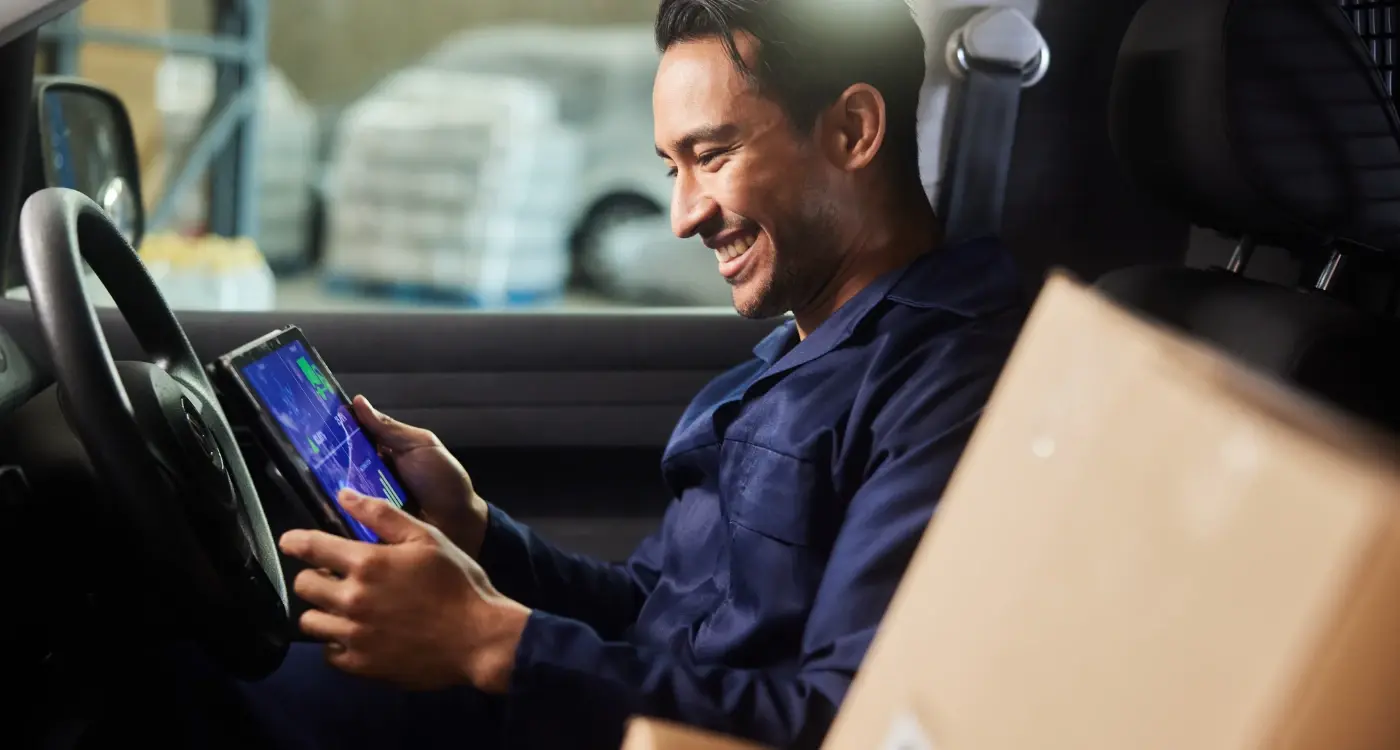What Features Should My Logistics App Have For Fleet Management?
Last month I was chatting to a logistics company owner who told me his biggest headache wasn't fuel costs or driver shortages—it was simply not knowing where his vehicles were at any given moment. He'd send out twenty delivery vans in the morning and spend the rest of his day playing phone tag, trying to work out which driver was running late, which one had broken down, and whether Mrs Johnson's parcel would actually arrive before 5pm as promised. Sound familiar?
This is exactly why fleet management apps have become so popular in recent years. They solve real problems that logistics companies face every single day. Whether you're running three delivery vans or three hundred trucks, having the right digital tools can transform your business from chaos into something that actually runs smoothly.
The difference between a good logistics operation and a great one often comes down to having the right information at the right time
Throughout this guide, we'll walk through the features that matter most for fleet management apps. We're talking about real-time tracking systems that show you exactly where your vehicles are, delivery management tools that keep customers happy, and route planning features that save time and fuel. Each chapter covers a different aspect of what makes a logistics app truly useful—not just another piece of software that sits unused on someone's phone.
Core Fleet Management Features
After years of working with logistics companies—and trust me, I've seen some absolute disasters when it comes to fleet management—I can tell you that getting the basics right is what separates successful operations from chaotic ones. Your fleet management app needs to handle the fundamental stuff before you even think about fancy bells and whistles.
The core features aren't glamorous, but they're the backbone of everything your drivers and managers will do daily. Without these solid foundations, you're building on quicksand.
Must-Have Core Features
These features form the foundation of any decent fleet management system:
- Vehicle location tracking and mapping
- Driver check-in and status updates
- Basic route planning and navigation
- Delivery confirmation and proof systems
- Simple reporting and analytics dashboard
- Vehicle inspection checklists
- Emergency contact and breakdown reporting
What I love about focusing on core features first is that they solve real problems that happen every single day. Your drivers need to know where to go, your managers need to know where vehicles are, and your customers need proof their goods arrived safely. Get these working smoothly and you've already solved 80% of your fleet headaches.
Real-Time Vehicle Tracking Systems
Real-time vehicle tracking is the backbone of any decent fleet management app—without it, you're basically flying blind. This feature uses GPS technology to show you exactly where every vehicle in your fleet is at any given moment, updated live as they move around. No more guessing games or waiting for drivers to call in with updates.
The system works by installing GPS devices in each vehicle that communicate with your app through mobile networks. You'll see all your vehicles displayed on a digital map, complete with their current location, speed, and direction of travel. Most systems update every few seconds, giving you an accurate picture of what's happening right now.
Key Benefits for Your Business
Beyond just knowing where your vehicles are, real-time tracking helps with delivery scheduling and customer service. When a customer calls asking about their delivery, you can give them an exact time estimate based on the driver's current location and traffic conditions. This transparency builds trust and reduces those awkward "where's my stuff?" conversations.
Choose tracking systems that work offline too—GPS devices should store location data locally when mobile signal is poor, then upload it once connection returns.
Security and Theft Prevention
Real-time tracking acts as a powerful deterrent against vehicle theft and unauthorised use. You'll receive instant alerts if vehicles move outside designated areas or operate during unusual hours, allowing you to respond quickly to potential security issues.
Driver Management and Communication Tools
Managing drivers isn't just about knowing where they are—it's about keeping them connected, informed, and working at their best. After building logistics apps for nearly a decade, I've learnt that the difference between a good fleet app and a great one often comes down to how well it handles driver management and communication.
Your app needs to make life easier for drivers, not harder. This means giving them clear instructions, letting them report issues quickly, and keeping communication flowing both ways. When drivers feel supported by the technology they're using, they perform better and stay with your company longer.
Essential Driver Communication Features
The core communication tools your logistics app should include are straightforward but powerful. Real-time messaging lets dispatchers send updates instantly—whether it's a route change or delivery instructions. Digital delivery confirmation removes paperwork headaches; drivers can capture signatures, take photos, and update delivery status with a few taps.
- In-app messaging between drivers and dispatch
- Push notifications for urgent updates
- Digital proof of delivery with photo capture
- Driver performance tracking and feedback
- Shift scheduling and time tracking
- Emergency alert system
Performance Monitoring That Actually Helps
Performance tracking shouldn't feel like surveillance. The best driver management tools focus on helping drivers improve rather than catching them out. Speed monitoring, delivery time tracking, and fuel efficiency reports give managers the data they need whilst providing drivers with feedback they can actually use to get better at their jobs.
Route Planning and Optimisation
Route planning is where the magic happens in fleet management—it's the difference between drivers wandering around like lost tourists and getting deliveries done efficiently. Your logistics app needs smart route optimisation that goes beyond basic GPS directions. We're talking about systems that consider traffic patterns, delivery windows, vehicle capacity, and driver break times all at once.
The best route planning features use algorithms that can process dozens of variables simultaneously. They'll factor in real-time traffic data, road restrictions for larger vehicles, and even weather conditions that might slow things down. Some apps I've worked on can recalculate routes instantly when new orders come in or when there's an unexpected delay.
Dynamic Route Adjustments
Static routes are old news. Modern fleet management apps need dynamic routing that adapts throughout the day. When a customer reschedules a delivery or traffic builds up unexpectedly, the system should automatically suggest alternative routes to keep everything on track.
Good route optimisation can reduce fuel costs by up to 20% whilst improving customer satisfaction through better delivery times
Multi-stop optimisation is where things get really interesting. Your app should handle complex delivery schedules with multiple stops, working out the most efficient sequence automatically. This saves hours of manual planning and reduces the chance of human error messing up your carefully planned routes.
Maintenance Scheduling and Vehicle Health Monitoring
Fleet vehicles work harder than most cars—they're on the road constantly, carrying heavy loads, and putting serious miles on the clock. Without proper maintenance scheduling, you'll find yourself dealing with breakdowns at the worst possible moments; usually when you've got urgent deliveries to make.
Smart maintenance scheduling works by tracking each vehicle's mileage, engine hours, and service history. The app sends automatic alerts when services are due, whether that's oil changes, tyre rotations, or MOT renewals. No more sticky notes on dashboards or hoping drivers remember to mention that strange noise the engine's been making.
Real-Time Vehicle Health Monitoring
Modern fleet management apps connect directly to your vehicle's diagnostic systems. They monitor engine performance, fuel efficiency, brake wear, and dozens of other health indicators in real-time. When something starts going wrong, you'll know about it before it becomes a expensive problem.
Cost Control Through Prevention
Preventive maintenance costs a fraction of emergency repairs. The app helps you spot patterns—maybe one driver is particularly hard on clutches, or certain routes cause more wear and tear. This data helps you make informed decisions about vehicle replacement, driver training, and route planning. You can even schedule maintenance during quiet periods to minimise disruption to operations.
Fuel Management and Cost Control
Fuel costs can eat up your budget faster than you might expect—and without proper tracking, you'll never know where all that money is going. A decent fleet management app needs to monitor fuel consumption across your entire fleet, giving you real-time data on which vehicles are guzzling petrol and which drivers might need a gentle word about their driving habits.
The best fuel management features don't just track spending; they spot patterns that could save you thousands. Your app should flag unusual fuel consumption, track mileage per gallon for each vehicle, and even integrate with fuel card systems to prevent unauthorised purchases. Some apps can detect potential fuel theft or highlight vehicles that need maintenance based on declining fuel efficiency.
Cost Control Features That Actually Work
Smart budgeting tools within your fleet app can set spending limits for different vehicle categories and send alerts when costs spike unexpectedly. You'll want features that compare fuel prices at different stations along planned routes—because every penny saved per litre adds up across hundreds of deliveries.
- Real-time fuel consumption monitoring
- Fuel card integration and fraud detection
- Cost comparison tools for petrol stations
- Driver behaviour analysis for fuel efficiency
- Budget alerts and spending limits
- Maintenance cost tracking and predictions
Set up automated reports that show fuel efficiency trends over time—this helps identify which vehicles need replacing and which drivers could benefit from eco-driving training.
Cost control isn't just about fuel though. Your app should track maintenance expenses, insurance costs, and vehicle depreciation to give you the complete financial picture of your fleet operations.
Delivery Management and Customer Communication
Your customers want to know where their stuff is—it's that simple. When someone orders something, they don't want to sit there wondering if it'll turn up today, tomorrow, or next week. A good logistics app needs proper delivery management features that keep everyone in the loop.
The best delivery management systems let you track each package from warehouse to doorstep. Drivers can update delivery status with a quick tap, marking items as 'out for delivery', 'delivered', or 'attempted delivery'. Customers get automatic notifications through SMS or email, so they know exactly what's happening with their order. Photo proof of delivery is becoming standard too—drivers snap a quick picture showing where they left the package.
Smart Customer Communication Features
Modern customers expect real-time updates. Your app should send notifications when drivers are nearby, giving customers a 30-minute heads up. Some apps even show a live map so people can watch their delivery approaching—bit like watching a pizza tracker, but for everything else.
Delivery Management Tools
- Real-time delivery status updates
- Customer notification system (SMS/email/push)
- Photo proof of delivery
- Electronic signature capture
- Failed delivery management
- Customer feedback collection
Two-way communication works best. Customers should be able to leave delivery instructions, reschedule deliveries, or contact drivers directly through the app. This cuts down on failed deliveries and keeps everyone happy.
Conclusion
Building a fleet management app isn't just about adding features and hoping for the best—it's about understanding what your drivers need, what your dispatchers rely on, and what keeps your customers happy. I've watched plenty of logistics companies struggle with apps that look impressive but miss the mark on basic functionality.
The features we've covered aren't optional extras; they're the backbone of modern fleet operations. Real-time tracking gives you visibility, driver management tools keep your team connected, and route optimisation saves time and fuel. Maintenance scheduling prevents costly breakdowns whilst delivery management keeps customers informed.
What matters most is how these features work together. Your tracking system needs to talk to your delivery management tools. Your route planning should consider maintenance schedules. Your fuel management data should inform cost control decisions. It's this integration that separates a good app from one that actually transforms your business.
Start with the features that solve your biggest pain points—whether that's late deliveries, fuel costs, or vehicle downtime. You can always add more functionality later, but getting the core features right from the beginning will set you up for success. Your fleet management app should make your life easier, not more complicated.
Share this
Subscribe To Our Learning Centre
You May Also Like
These Related Guides

How Do I Handle Driver Management And Scheduling In My Delivery App?

Should My Farming App Include Financial Management And Budgeting Features?



